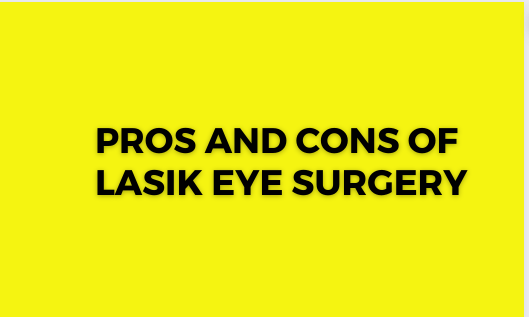Lasik eye surgery is a popular refractive procedure that corrects vision problems, such as nearsightedness, farsightedness, and astigmatism. It involves reshaping the cornea using a laser, leading to improved visual acuity. In the following list, we present pros and cons of Lasik eye surgery, highlighting its benefits and potential drawbacks.
Pros:
- Improved vision: Lasik surgery can significantly improve visual acuity, reducing or eliminating the need for corrective lenses.
- Quick procedure: The surgery itself is relatively quick, typically taking only a few minutes per eye.
- Rapid recovery: Many patients experience a quick recovery and notice improved vision within a day or two after the procedure.
- Long-term results: Lasik surgery often provides long-lasting vision correction, reducing the need for ongoing prescription changes.
- Enhanced quality of life: Improved vision can enhance daily activities, such as driving, reading, and participating in sports.
- No dependence on glasses or contacts: Lasik surgery reduces or eliminates dependence on glasses or contact lenses for most visual tasks.
- Convenience and freedom: Freedom from glasses and contacts offers convenience, especially during physical activities or travel.
- Versatility: Lasik surgery can address a range of refractive errors, including nearsightedness, farsightedness, and astigmatism.
- Predictable outcomes: Lasik outcomes are generally predictable, and the majority of patients achieve their desired visual results.
- Minimal pain and discomfort: The surgery itself is usually painless, with minimal discomfort experienced during the recovery period.
- Improved self-confidence: Corrected vision through Lasik surgery can boost self-confidence and self-esteem.
- Minimal downtime: Most patients can resume normal activities within a few days of the procedure.
- Reduced risk of eye infections: Eliminating the need for contact lenses reduces the risk of eye infections associated with their use.
- Enhanced peripheral vision: Lasik surgery can improve peripheral vision, expanding the visual field.
- Customized treatment: Lasik procedures can be tailored to each individual’s specific vision needs for optimal results.
- Less reliance on corrective aids: Reduced dependence on glasses or contacts can lead to cost savings over time.
- Safe and well-established: Lasik surgery has a high success rate and is considered a safe and well-established procedure.
- Improved night vision: Many patients experience improved night vision and reduced glare after Lasik surgery.
- Corrected depth perception: Lasik surgery can improve depth perception and visual clarity.
- Simplified daily routine: Freedom from glasses or contacts simplifies daily routines, eliminating the need for cleaning, maintenance, and lens replacements.
Cons:
- Potential risks and complications: As with any surgery, Lasik carries potential risks and complications, such as dry eyes, glare, halos, or visual fluctuations.
- High cost: Lasik surgery can be expensive, and insurance may not cover the full cost.
- Not suitable for everyone: Some individuals may not be suitable candidates for Lasik surgery due to various factors, such as thin corneas or unstable vision.
- Temporary discomfort: Some patients experience temporary discomfort, dryness, or sensitivity in the eyes after the procedure.
- Regression of results: In some cases, the effects of Lasik surgery may regress over time, requiring additional procedures or adjustments.
- Limited correction range: Lasik surgery may not be suitable for severe refractive errors or certain complex vision conditions.
- Visual side effects: While rare, some patients may experience visual side effects, such as halos, glare, or double vision.
- Pre-operative requirements: Candidates for Lasik surgery need to meet specific pre-operative requirements, which may include stable vision and good overall eye health.
- Potential for overcorrection or undercorrection: In some cases, the desired vision correction may not be achieved or may result in overcorrection or undercorrection.
- Temporary visual fluctuations: It is common for vision to fluctuate during the healing process after Lasik surgery, requiring some adjustment time.
- Dry eyes: Dry eye symptoms can occur after Lasik surgery, although they are usually temporary and can be managed with proper care.
- Post-operative care: Following Lasik surgery, patients need to adhere to post-operative care instructions and attend follow-up appointments.
- Loss of near vision: While Lasik surgery corrects distance vision, it may lead to a temporary or permanent loss of near vision, requiring reading glasses.
- Risk of infection or inflammation: In rare cases, Lasik surgery can lead to infections or inflammation in the eyes.
- Pregnancy limitations: Lasik surgery is generally not recommended during pregnancy or while breastfeeding.
- Flap complications: Lasik involves creating a corneal flap, which carries the risk of flap complications, although they are rare.
- Potential for underwhelming results: Some patients may have high expectations for vision improvement that may not be fully met with Lasik surgery.
- Age limitations: Lasik surgery is typically recommended for individuals over a certain age, as vision stability is an important factor.
- Long-term implications: The long-term effects of Lasik surgery on eye health and potential changes in vision over time are still being studied.
- Recovery time: While most patients experience a quick recovery, it may take several weeks or months for vision to stabilize fully.
Pros
- Improved vision
- Quick procedure
- Rapid recovery
- Long-term results
- Enhanced quality of life
- No dependence on glasses or contacts
- Convenience and freedom
- Versatility
- Predictable outcomes
- Minimal pain and discomfort
- Improved self-confidence
- Minimal downtime
- Reduced risk of eye infections
- Enhanced peripheral vision
- Customized treatment
- Less reliance on corrective aids
- Safe and well-established
- Improved night vision
- Corrected depth perception
- Simplified daily routine
Cons
- Potential risks and complications
- High cost
- Not suitable for everyone
- Temporary discomfort
- Regression of results
- Limited correction range
- Visual side effects
- Pre-operative requirements
- Potential for overcorrection or undercorrection
- Temporary visual fluctuations
- Dry eyes
- Post-operative care
- Loss of near vision
- Risk of infection or inflammation
- Pregnancy limitations
- Flap complications
- Potential for underwhelming results
- Age limitations
- Long-term implications
- Recovery time



